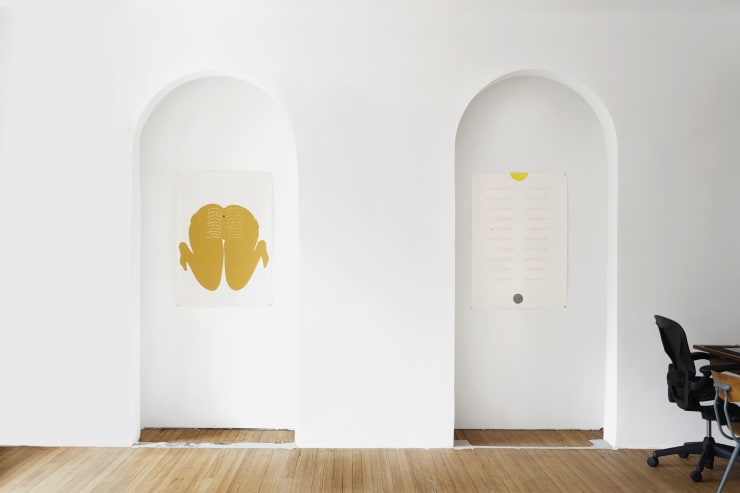Press Release
Pablo's Birthday is pleased to present a summer group exhibition showcasing the work of Claudia Bitrán, Eckart Hahn, Kubra Khademi, Seyhr Qayum, and Paul Vogeler. The works in this exhibition resonate with fetishistic significance, where the visual images are venerated as representational objects and believed to have magical or supernatural potency.
The term "fetish" has evolved over the decades to arrive at an idiom that played a central role in the perception and study of non-Western art, and in African art, particularly in modern times. Fétichisme was first used in an erotic context in 1887 by Alfred Binet. “The Modern Fetish” by Donald Kuspit —published in Artforum in 1988— inaugurates the fetishistic art theory as it is applied to modern art.
“Any object capable of remaining intact outside the body so that it may at the same time be visually introjected” can operate fetishistically. In these terms, then, one way of compensating for a sense of lack in the body is through the supplement of the work of art. In fact, what more reliable source can this fantasy demand than works of art, whose presumable immortality—“eternal presence,” as it has been called—signals indestructibility?” - Phyllis Greenacre “Certain Relationships,” Donald Kuspit, “The Modern Fetish,” Artforum, October 1988.
By engaging with various vocabularies and tools, the works presented in this exhibition share a common understanding of the symbolic connotations that may emanate from the visual power of an object. There are recurrent symbols in the paintings of Eckart Hahn. Animals and objects interact with ropes and chains but seem un-menaced as if they inhabit another place beyond gravity and constraint. His work has been tied to S&M culture, where an emphasis on trust and confidence plays a role in the mastery and submission that the ropes represent. These binaries stand out, either by the artist living in a paradoxical society, or through the relationship between nature and culture, the power play of freedom and control, or of authenticity and artificiality.
Claudia Bitrán is obsessed with the representation of the pop culture imaginary, which functions as a sort of fetish itself. Bitrán has been compulsively collecting Brittney Spears’ private and public images over the years and, in turn, creating a series of works based on them. When photographed by paparazzi, Britney has been seen multiple times carrying two drinks: a large coffee in one hand and a soda in the other. “What is the fuel needed to continue existing in a body that is the focus of a never-ending spectacle?” Driven by labor, affect, humor, and destruction, the artist catapults herself into the hyperbolic world of pop with the task of deconstructing and rewriting mega known spectacles. In direct reference to Kuspit’s essay, Bitrán’s work makes clear that the media creates seductive, thoroughly artificial fetish objects through its mechanical process. “I both fantasize as a fan, and sever as a critic, frantically attempting to introduce subjectivity and alternative realities into the highly calculated systems of mass consumption.”
“The Hole” series by current ISCP resident Kubra Khademi is inspired by the poem of the Persian poet Rumi titled “Hole of Prayers.” Specifically created for the exhibition, in these works Khademi continues manifesting how literature, poetry, and the oral expressions in popular Afghan culture fuel inspiration in her visual practice. The words conduct a fetishistic power in the creation of the images under a compelling metaphor. “Hole” can be used in any context, it is used in discussions, contradictions, praises, curses, creation, annihilation, invasion, or loss. “What inspired me to use “hole” as the core of this series is both its simplicity and complexity in opening a rich dialogue on culture, religion, and politics.” Through her practice, Kubra Khademi explores her life as a refugee and a woman. Her multidisciplinary practice is a response to a male-dominated society with an extreme patriarchal policy.
Paul Vogeler’s work is raw, reflecting upon the human experience and mortality. His most recent body of work continues with an ongoing search for the physical symbols that reveal an eternal spiritual realm and mirror the feeling of being human. His canvases connect us with the most profound human expressions. Thus his subjects are unquestionably fetishistic and fetishized –some explicitly depicted on the canvas– in his work, Vogeler is able to transcend the obvious to connect with our most profound sentiments of desire and possession, lying between life and death in connection with that ultimate sense of divinity.
Jars, bones, cords, ropes, soda, pop stars, holes, words, jewelry, mimesis, and illusion, connected to or activated by the body: all form a part of the fetishist’s magic in the artful universe. And, as fetishes, they give us, for a while, the feeling that a world not ruled by our common laws does exist, a marvelous and uncanny world. - Chasseguet-Smirgel, Creativity and Perversion, 1984.











